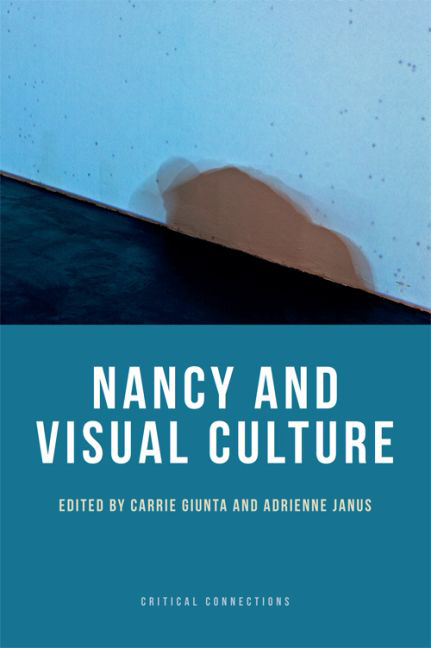Book contents
- Frontmatter
- Contents
- List of illustrations
- Acknowledgements
- Introduction: Jean-Luc Nancy and the Image of Visual Culture
- 1 Cutting and Letting-Be
- 2 Dancing Equality: Image, Imitation and Participation
- 3 A Question of Listening: Nancean Resonance, Return and Relation in Charlie Chaplin
- 4 The Image: Mimesis and Methexis
- 5 On the Threshold: Visual Culture, Invisible Nature
- 6 Pornosophy: Jean-Luc Nancy and the Pornographic Image
- 7 Presentation and Disappearance: Dialogue between Soun-Gui Kim and Jean-Luc Nancy
- 8 Writing in the Place of the Animal
- 9 Together at the Limit: Jean-Luc Nancy, Art and Community
- 10 Turning Around the Written Mark, Opening from a Weight of Thought
- 11 Uncanny Landscapes of Photography: The Partage of Double-Exposure after Jean-Luc Nancy
- Contributors
- Bibliography
- Index
3 - A Question of Listening: Nancean Resonance, Return and Relation in Charlie Chaplin
Published online by Cambridge University Press: 15 September 2017
- Frontmatter
- Contents
- List of illustrations
- Acknowledgements
- Introduction: Jean-Luc Nancy and the Image of Visual Culture
- 1 Cutting and Letting-Be
- 2 Dancing Equality: Image, Imitation and Participation
- 3 A Question of Listening: Nancean Resonance, Return and Relation in Charlie Chaplin
- 4 The Image: Mimesis and Methexis
- 5 On the Threshold: Visual Culture, Invisible Nature
- 6 Pornosophy: Jean-Luc Nancy and the Pornographic Image
- 7 Presentation and Disappearance: Dialogue between Soun-Gui Kim and Jean-Luc Nancy
- 8 Writing in the Place of the Animal
- 9 Together at the Limit: Jean-Luc Nancy, Art and Community
- 10 Turning Around the Written Mark, Opening from a Weight of Thought
- 11 Uncanny Landscapes of Photography: The Partage of Double-Exposure after Jean-Luc Nancy
- Contributors
- Bibliography
- Index
Summary
In Jean-Luc Nancy's The Image: Mimesis and Methexis,1 he considers what makes us say that a portrait lacks only speech. This lack speaks, explains Nancy. A portrait ‘speaks to us from its privation of speech.’ Take the Mona Lisa, for instance. For if the Mona Lisa lacks only speech of her own, this evokes ‘something more and other than the sole privation of verbal expression’. The lack, for Nancy, is rather a transport carrying across a Mona Lisa voice, which is not manifested as speech. As her audience, we recognise her voice. What's more, this voice is understood: ‘we understand it … its sense and its truth’. Mona Lisa can make herself understood; yet she does not make herself heard (se fait entendre). Without uttering a word, her voice transports sense.
This bears similarity with listening to the voice of one who is absent. When only a photograph or a film carries the absent person's voice, listening is ‘an order other than the order of the visual’. Voice and speech are not the same thing, Nancy articulates in a mock conversation with Jacques Derrida in ‘Vox Clamans in Deserto’. ‘Because I know you, I recognised your voice as you were coming toward me, long before I could make out what you were actually saying’, Nancy says in addressing Derrida. This is to say that voice is prior to intelligibility. Voice comes before language.
In order to recognise Derrida's voice, Nancy listens. For Nancy, the main function of listening (l’écoute) is not simply to bear the weight of language as some requirement of intelligibility. Nancy questions a hierarchy of sensible and intelligible forms of listening. His Listening begins with an indecision: listening can be écouter or entendre – l’écoute or l'entente. A simple translation into English confounds the two terms, as both may be translated to the same word in English: listening. L'entente is about hearing and understanding the spoken word. L’écoute is more than intelligibility of language; it is attention to others.
Nancean listening is the attentiveness that is characteristic of dialogue. According to this theory, listening does not necessarily implicate hearing, nor is it the reverse of speech or hearing. L’écoute, for Nancy, is resonant listening.
- Type
- Chapter
- Information
- Nancy and Visual Culture , pp. 55 - 72Publisher: Edinburgh University PressPrint publication year: 2016



